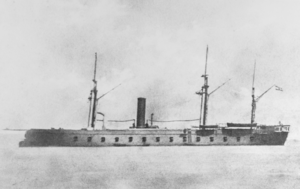SMS Kaiser Max (1862)

Illustration of Kaiser Max c. 1866
|
|
| History | |
|---|---|
|
|
|
| Name: | Kaiser Max |
| Builder: | Stabilimento Tecnico Triestino |
| Laid down: | October 1861 |
| Launched: | 14 March 1862 |
| Commissioned: | 1863 |
| Fate: | Scrapped, December 1873 |
| General characteristics | |
| Class and type: | Kaiser Max class |
| Displacement: | 3,588 t (3,531 long tons; 3,955 short tons) |
| Length: | 70.78 meters (232.2 ft) pp |
| Beam: | 10 m (33 ft) |
| Draft: | 6.32 m (20.7 ft) |
| Installed power: | 1,926 indicated horsepower (1,436 kW) |
| Propulsion: | 1 single-expansion steam engine |
| Speed: | 11.4 knots (21.1 km/h; 13.1 mph) |
| Range: | 1,200 nautical miles (2,200 km; 1,400 mi) at 10 knots (19 km/h; 12 mph) |
| Crew: | 386 |
| Armament: |
|
| Armor: | Belt: 110 mm (4.3 in) |
SMS Kaiser Max was the lead ship of the Kaiser Max class of armored frigates built for the Austrian Navy in the 1860s. Her keel was laid in October 1861 at the Stabilimento Tecnico Triestino shipyard; she was launched in March 1862, and was completed in 1863. She carried her main battery—composed of sixteen 48-pounder guns and fifteen 24-pounders—in a traditional broadside arrangement, protected by an armored belt that was 110 mm (4.3 in) thick.
Kaiser Max saw action at the Battle of Lissa in July 1866. She engaged the Italian coastal defense ship Palestro, which later exploded and sank after sustaining heavy Austrian fire. Kaiser Max emerged from the battle largely unscathed, save for minor damage to her funnel and rigging inflicted by the armored frigate Re d'Italia. After the war, Kaiser Max was modernized slightly in 1867 to correct her poor seakeeping and improve her armament, but she was nevertheless rapidly outpaced by naval developments in the 1860s and 1870s. Obsolescent by 1873, Kaiser Max was officially "rebuilt", though in actuality she was broken up for scrap, with only her armor plate, parts of her machinery, and other miscellaneous parts being reused in the new Kaiser Max.
Kaiser Max was 70.78 meters (232.2 ft) long between perpendiculars; she had a beam of 10 m (33 ft) and an average draft of 6.32 m (20.7 ft). She displaced 3,588 metric tons (3,531 long tons; 3,955 short tons). She had a crew of 386. Her propulsion system consisted of one single-expansion steam engine that drove a single screw propeller. The number and type of her coal-fired boilers have not survived. Her engine produced a top speed of 11.4 knots (21.1 km/h; 13.1 mph) from 1,926 indicated horsepower (1,436 kW). She could steam for about 1,200 nautical miles (2,200 km; 1,400 mi) at a speed of 10 knots (19 km/h; 12 mph).
...
Wikipedia
